Women and heart health – It’s worth caring about!
Do you know your cholesterol levels? If you’re a woman and don’t know your numbers, you’re far from alone - many women don’t take the risks of high cholesterol seriously and have never been tested by their GP. (Ref 1) Yet, nearly half of adult women in England (45%) have elevated cholesterol, which is one of the main risk factors of coronary heart disease (CHD). (Ref 2)

But only stressed out, overweight middle-aged men suffer with high cholesterol and CHD, right? Wrong! Despite the common belief that CHD is a man’s problem, CHD is actually the biggest killer of women, with more than 800,000 UK women living with the condition. In fact, CHD, which can lead to a variety of health problems, such as a heart attack or a stroke, kills more than twice as many women in the UK than breast cancer – claiming one in thirteen lives. (Ref 3)
Be more heart aware
Considering these stats and facts, it’s worrying that so many women – and even health professionals still don’t see CHD as a woman’s problem. (Ref 4) But women should take care, so they are able to spot the signs of a heart attack and seek help early to avoid more severe problems – which can dramatically reduce their chances of survival. On the up side, it’s estimated that there are around 380,000 female heart attack survivors living in the UK today. (Ref 5)
If you are looking for real-life examples on the topic, do check out the British Heart Foundation (BHF) podcast series – THE TICKER TAPES, which explores real stories of women on what life is actually like during and after a heart attack.
How women can protect themselves…
As well as recognizing symptoms, it’s vital that women are aware of the risk factors that could increase their chances of developing CHD, and take the necessary steps to keep their hearts healthy at every age.
If you’re a young and healthy woman, it’s all too easy to ignore the risk of developing CHD. But the life you lead now – the food you eat, the exercise you take and the lifestyle decisions you make – can influence your future heart health. And while it’s true that as a woman, your hormones might give you some protection against CHD in your pre-menopausal years, once you’ve been through the menopause your risk of developing it rises to the level of men’s – and continues to rise as you get older. (Ref 6, 7) The bottom line is that women need to be just as vigilant as men at looking after their heart health, especially after the menopause.
Read more: Menopause and the link with cholesterol
Get your risk factors checked…
All women (and men, too) aged between 40 and 74 in England are entitled to a free NHS Health Check every five years. This will include a cholesterol test, as well other simple tests like measuring your blood pressure, blood sugar levels and being weighed. The results will show you if you need to make any diet and lifestyle changes to protect your heart. In some cases, though, you could also be prescribed medication (called statins) to lower your cholesterol levels, and/or blood pressure pills.
“In its first five years, the NHS health Check is estimated to have prevented up to 8,400 heart attacks or strokes. For every 6 to 10 people screened, one person is identified as being at high risk of heart and circulatory diseases.” (Ref 8)
No matter how well you feel, don’t ignore the invitation, as this vital check up will give you and your GP a clearer picture of your heart health and if you’re at risk of health problems. Your GP surgery or local council will usually send you a letter inviting you to attend an NHS Health Check, but if you don’t get this and you’re over 40, you can always request it yourself. That said, why wait for your NHS Health Check? Making heart happy changes to your diet and lifestyle today, can give you greater health from today!
Know your numbers…
- Blood pressure should be 140/90mmHg or below
- Total cholesterol should be 5.0 mmol/l or below
- LDL cholesterol should be 3.0 mmol/l or below
- Non-HDL cholesterol should be 4.0 mmol/l or below
- HDL cholesterol should be 1.2 mmol/l or above
- BMI should be between 18.5 and 24.9
- Waist circumference should be below 80cm (31.5inches)
What are the risk factors for CHD?
Lots of different things can influence the health of a woman’s heart. And, even though you can’t change all of the risk factors of CHD, such as your age, gender, family history and ethnicity, the good news is that there is lots you can actively do to reduce your risk, or help stop things getting worse; the main ones centre on adopting healthy diet and lifestyle habits, and how you look after your body and overall health.
Here we’ll explore some of the key modifiable risk factors for CHD, see how women fare in 2021, and what you can do as a woman to look after your heart at every age.
1. High cholesterol
Cholesterol is a wax-like, fatty substance that circulates in our blood. It’s essential for our bodies to function normally, but when you have too much cholesterol in your blood, it builds up on the walls of your arteries causing them to narrow and harden – making it harder to flow easily though. This condition, known as atherosclerosis is the starting place of most CHD. Indeed, it’s reported that 45% of deaths in the UK from CHD are attributed to high levels of cholesterol. (Ref 9)
Women and high cholesterol
According to the latest figures from the Health Survey for England (HSE), which monitors trends in the nation’s health, the number of women with elevated total cholesterol has declined over the past two decades from 67% to 45% (Ref 2), which is a move in the right direction! But, there’s no room for complacency as cholesterol levels are higher among women, than men (40%), and there are still a huge number of women – especially among those aged between 55 to 64 years – with cholesterol levels that are too high, putting them at risk of CHD.
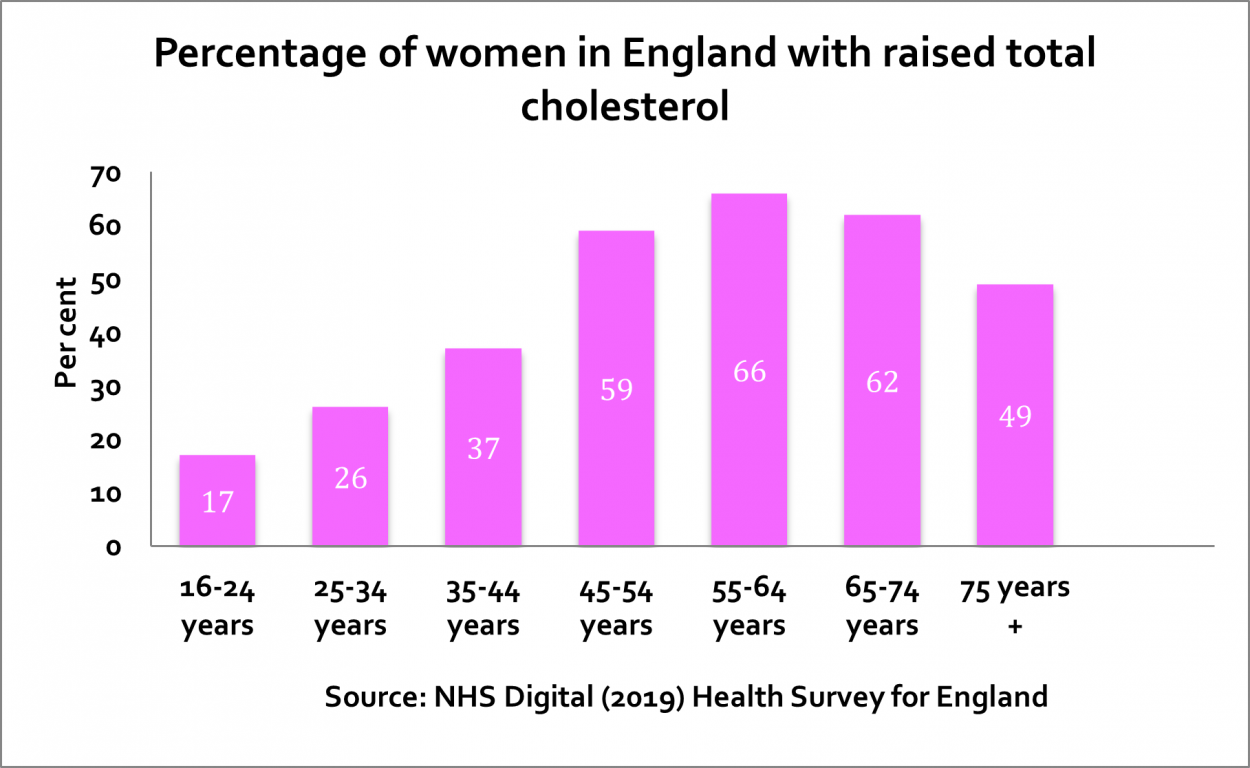
What you can do to keep your cholesterol levels on track?
- Reduce the amount of saturated fat you eat (butter, coconut oil, full-fat milk and dairy products, chocolate, puddings, pastries, and fatty cuts of meat). The latest National Dietary and Nutrition Survey reveals that, on average, women between 19 and 64 years are consuming 22.5g of saturated fat per day, which is higher than recommended limit (20g). (Ref 10)
- Swap saturated fats for heart healthy unsaturated fats such as olive, rapeseed or sunflower oil, oily fish, nuts and seeds.
- Eat plenty of fruits and vegetables (at least 5-A-Day) and a variety of types and colours; they provide a wide range of vitamins, minerals and fibre that may help reduce the risk of CHD. (Ref 11)
- Cut back on refined carbohydrates and foods containing excess sugars. Instead, where possible choose starchy foods that are high in fibre and those containing wholegrains, such as wholemeal bread, porridge oats, or wholegrain breakfast cereals. (Ref 12)
- Introduce more cholesterol lowering foods into your daily routine. Benecol® foods contain added plant stanols, an active ingredient which is clinically proven to lower cholesterol. A daily intake of 1.5-2.4g plant stanols can lower cholesterol by 7-10% in 2-3 weeks, as part of a healthy diet and lifestyle, with lots of fruits and vegetables.*
Read more:
Healthy Foods to Lower Cholesterol
Plant Stanols – From nature to cholesterol lowering
2. Poor dietary habits
A healthy, balanced diet is one of the biggest – and best – tools you have to look after your heart health. In fact, scientists have estimated that 67% of CHD deaths in the UK are linked to a poor diet – characterised by too little wholegrains and fruit and too much salt, and also not enough vegetables, nuts and seeds, and omega-3 fatty acids. (Ref 11, 13)
Women and diet
Results from the latest National Diet and Nutrition Survey, which gives an insight into the nation’s eating habits, reveals that although there have been some positive changes in UK women’s diets over the years, there’s still some room for improvement. Many women’s diets aged between 19 and 64 years are too high in saturated fat, free sugars and salt, and low in fibre, oily fish and fruit and vegetables. (Ref 10, 14) Let’s take a deeper look:
Eating at least five portions of fruit and vegetables a day (a portion weighs 80g) is a key part of a heart healthy diet, but on average, only 33% of adult women manage to do so – the typical number of portions consumed is 4.3 each day. (Ref 10, 11)
Salt is our biggest source of sodium, and too much sodium contributes to high blood pressure. On average, most women are consuming approximately 7.6g a day – nearly 30% more than they should. (Ref 11, 14)
Oily fish such as trout, salmon, herring, sardines and mackerel, contains omega-3 fatty acids, which are a group of unsaturated fats that our bodies need to help maintain a normal healthy heart. It’s recommended that everyone should eat at least two portions (a portion is 140g) of fish a week, and one of them should be oily. But, most women struggle to achieve this amount – on average, adult women only manage 56g each week, which is around a third of the recommended amount. (Ref 10)
Free sugars, such as table sugar, honey and syrups, should not make up more than 5% of our daily calories – that’s around 30g a day (or 7 sugar cubes), as they provide little more than calories, so are not necessary for a healthy diet. Eating too much can lead to excess calories and in turn, weight gain and obesity – a risk factor for CHD. (Ref 15) Unfortunately, on average, adult women are consuming 44 grams free sugars per day, which is nearly 50 per cent more the recommended daily limit. (Ref 10)
Eating more wholegrains and plenty of fibre rich carbs, such as wholewheat pasta, skin on potatoes and brown rice, is good for your digestive health – and it’s good for your heart, too. (Ref 16) But despite the benefits, average fibre intakes among adult women remain woefully low. On average, women aged between 19-64 years are consuming just 18.1 grams of fibre per day – that’s over a third less than recommended (30g). And older generations are not fairing much better, at 18.5g for women aged 65-74 years, and 16.3 grams for the over 75s. (Ref 10, 15)
What you can do eat well?
The key is to enjoy a healthy, balanced diet: plenty of plant-based foods such as fruit, vegetables, wholegrains, legumes, nuts and seeds, contains two weekly portions of fish, limits saturated fat, sugar and salt, and doesn’t exceed healthy limits for alcohol.
There’s good evidence that plant-based dietary patterns like the Mediterranean, the dietary approaches to stop hypertension (DASH) diet, as well as vegetarian – or vegan-type diet patterns can go a long way towards lowering your risk of CHD. (Ref 17)
Why not print off the Government’s Eatwell Guide and stick it on a kitchen cupboard or a fridge to remind you to build a healthy, balanced plate at each meal.
3. High blood pressure
Blood pressure is the measure of the force that your heart uses to pump blood around your body. Maintaining or bringing down your blood pressure is another one of the most important self-help measures you can take to reduce your risk of developing CHD. (Ref 3)
Women and high blood pressure
High blood pressure, or hypertension means your blood pressure is equal to or higher than the recommended level (140/90mmHg). According to the HSE, 22% of women aged between 45 and 54 years have hypertension, including 12% untreated hypertension. This rises to more than half – 51% – of 65-74 year olds, and two-thirds – 65% – of those aged 75 and over. (Ref 2)

What you can do to keep your blood pressure on track?
Cut down on salt – salt is the major contributor to high blood pressure because it disrupts the natural sodium balance in the body. This causes fluid retention, which raises blood pressure. In the UK, it’s recommended we don’t exceed 6g of salt a day, which is about one teaspoon; but on average most women consume 7.6g a day. (Ref 14)
- Change your seasoning and reduce adding salt to food – use herbs, spices, chili and lemon juice to flavour your food instead – your taste buds will soon adapt.
- Eat fewer processed foods, as these are where most (75%) of the salt in our diets comes from – ready meals, ready made sauces, soups, pickles and snacks. Look at on-pack food labels so you can choose brands with the lowest salt content.
- Don’t be hoodwinked into thinking that ‘posh’ salts are any better for you. They’re all salt and so will push up your blood pressure levels.
- Keep processed meats to a minimum. Bacon, ham and sausages, for example, all traditionally contain high levels of salt.
- Cook from scratch whenever possible, as it allows you to control the ingredients and adapt recipes to make them lower in salt.
- Eat more potassium-rich foods, such as vegetables and fruits (fresh and dried), potatoes, nuts and seeds and pulses as they can help to control blood pressure by balancing out the negative effects of salt. (Ref 11)
4. Weight and waist size
Being overweight or obese puts an extra strain on your heart and also makes other risk factors for CHD more likely, such as high cholesterol and type 2 diabetes. (Ref 18, 19)
Body mass index (BMI) is one way to tell if you’re overweight or obese. Aim for a healthy BMI of between 18.5 and 24.9.
Your shape matters too. Women come in all shapes and sizes, but where you carry any excess weight is also important. Being an ‘ apple’ (excess weight around your waist) makes you even more at risk of developing CHD, than being a ‘pear’ (excess weight is concentrated on the hips), so try to aim for a waistline of 80cm (31.5 ins) or below.
It’s important to realise these measurements are only a guide and your doctor may recommend different BMI and waist size goals for you, depending on other risk factors you have such as your ethnic origin.
Women, weight and waist size
According to the HSE the majority of women in England are overweight or obese (60%) Added to this, 70% of women had a higher than desirable waist measurements – the proportion increases broadly in line with age, from 36% of women aged between 16 and 24 years, to 86% of those aged 75 years and over. (Ref 2)
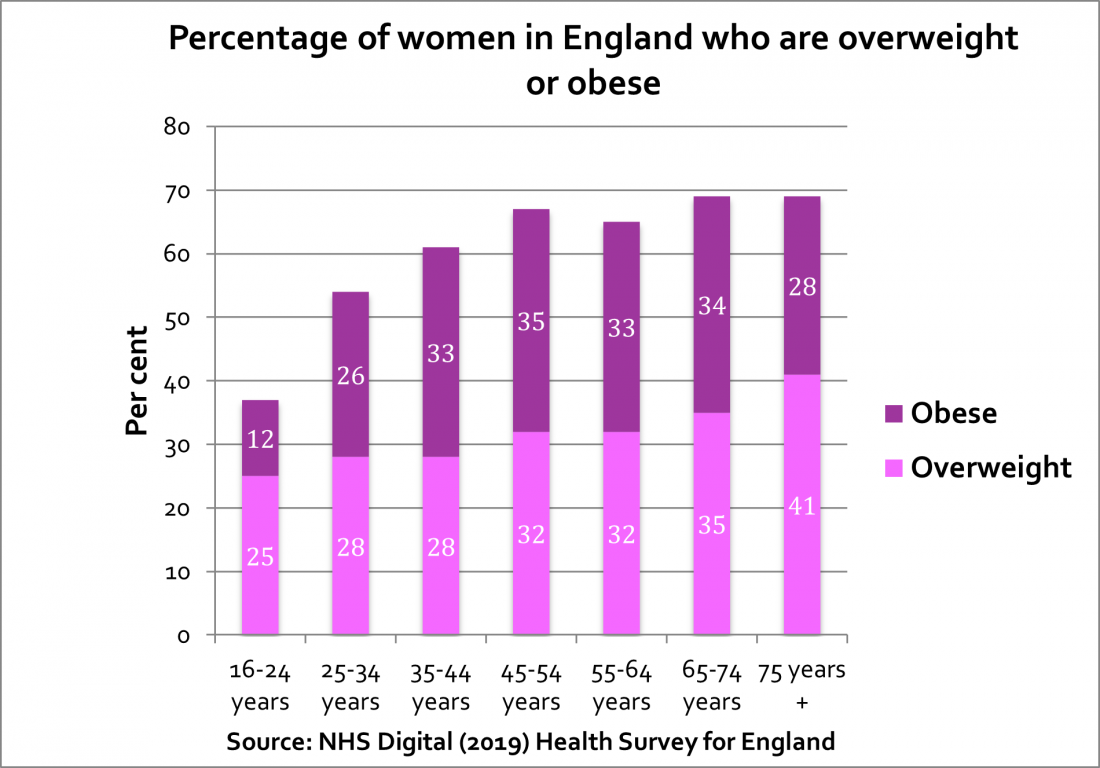
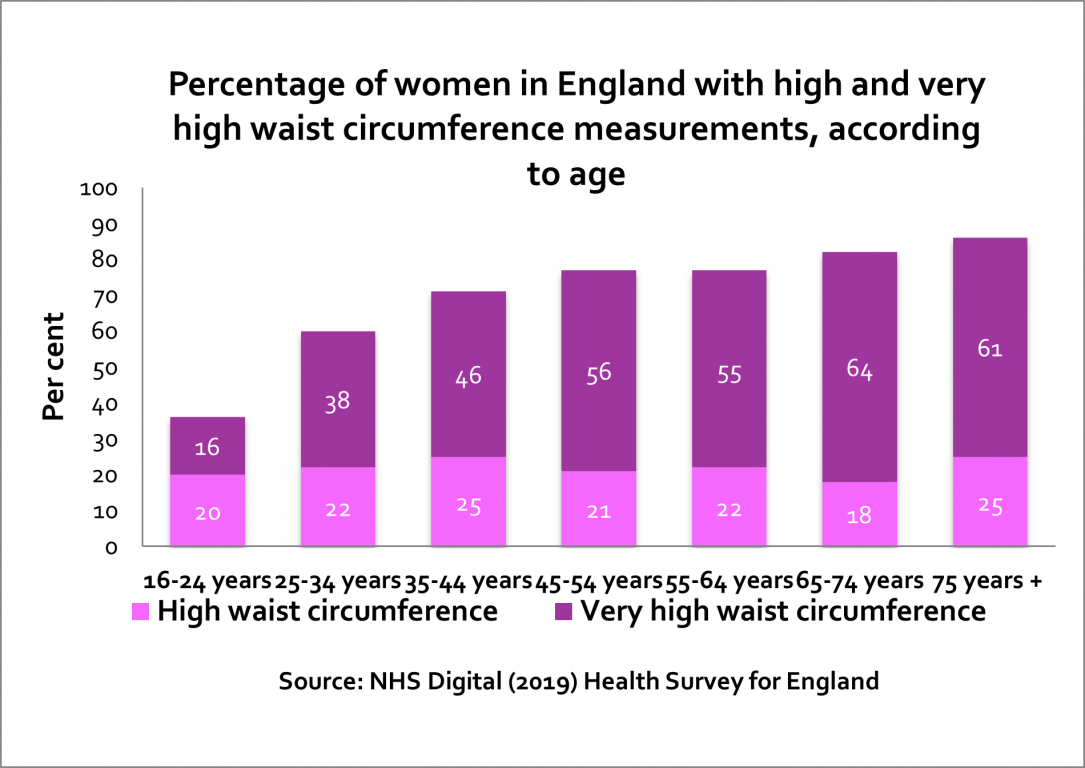
What you can do to keep your weight on track?
Remember ‘faddy’ diets aren’t a long-term solution to losing weight and keeping it off because they are hard to stick to. So if you need to lose weight – especially if the extra pounds sit on your tummy – plan to make healthy, balanced changes to the way you’re eating, while controlling your portions and being more physically active. And don’t try to lose weight too quickly – about 1-2 lbs (0.5-1kg) is about right.
5. Alcohol
Drinking too much alcohol is not just bad for your liver – it’s bad for your heart, too. (Ref 20, 21) Plus, alcohol is high in calories – an excess of which can lead to unwanted weight gain. It is encouraging that around two thirds of women in England – 62% – drink at levels, which puts them at lower risk of alcohol related harm, that is, 14 units or less in the week. Nevertheless, a fifth of women (20%) aged between 55 and 64 years exceed national guidelines for weekly alcohol intake. (Ref 2)

What you can to cut down on alcohol?
- Alternate any alcohol containing drinks with low calorie soft drinks or a glass of water to rehydrate.
- Get inventive with alternatives – try NoLo (alcohol free and low alcohol drinks) and mocktails.
- Find new ways to unwind at the end of the day – try yoga, a cup of chamomile tea or a long soak in the bath.
6. Smoking
If you want to protect your heart, smoking has got to be a no-no! Chemicals in cigarette smoke damage arteries, force your heart to work harder and make blood more likely to clot. The risk to your health starts to drop soon after you give up – so it’s never too late to quit. (Ref 22)
Women and smoking
At least 1 in 7 women still smoke in England. It’s correct that smoking among women has nearly halved since 1993, when 26% women were regular smokers, but we still have a long way to go, particularly where young women are concerned. The proportion of women who currently smoke is highest among the under 35’s. (Ref 2)
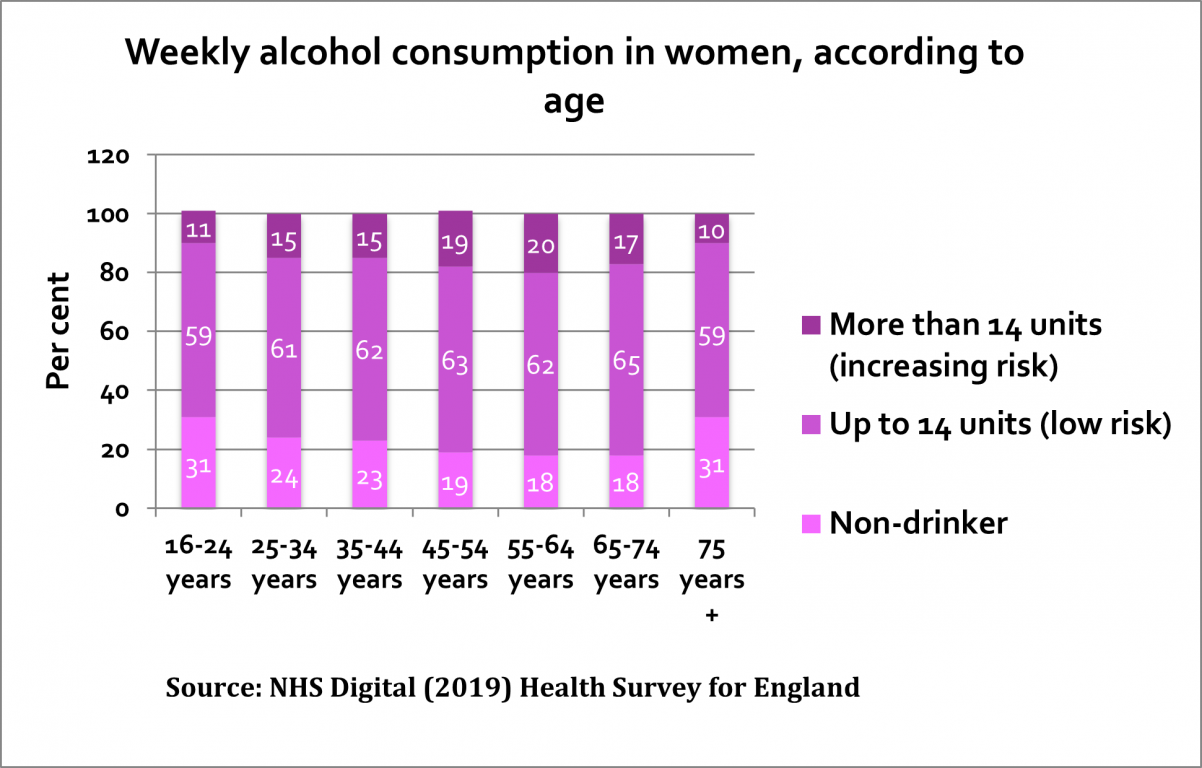
What you can do to ‘snub out’ the habit?
- Ask your GP or practice nurse for advice on giving up. Or visit the NHS website for advice on medications that could help you quit.
- Spend some time thinking about why and when you smoke, so that you can identify your weak moments in the day, and allow your friends and family to give you vital support.
- Put aside the money you would spend on cigarettes each week for something special as your reward, or add it to a sponsorship fund and raise money for a charity your supporters can donate to.
7. Physical Activity
Like any muscle, your heart benefits from being exercised. Exercising regularly can not only make your heart stronger but also help to increase ‘good’ HDL cholesterol, look after your weight and keep your blood pressure down. In fact, it’s estimated that being more physically active throughout your lifetime can reduce your risk of CHD by as much as 35%. (Ref 23)
To protect your heart, maintain or improve fitness, women (aged 19 and over) should aim for at least 150 minutes (2 1/2 hours) of moderate intensity activity a week (that means feeling your heart beat faster, getting a little out of breath and sweaty, but still be able to hold a conversation), such as brisk walking, dancing, gardening, or even housework and domestic chores.
Alternatively, you can do 75 minutes of high intensity activity each week, such as jogging, high-impact aerobics or skipping. Plus, do strength exercises at least twice such as lifting weights or heaving shopping bags or yoga, to keep your muscles strong. (Ref 24, 25)
Women and exercise
According to physical activity surveys, while women are slightly less active than men (70%), around two thirds of women (65%) still meet the recommended exercise target. Sadly, a fifth of women (22%) were considered to be inactive – that’s exercising less than 30 minutes on average per week – and so could benefit from moving more to protect their heart. (Ref 26)
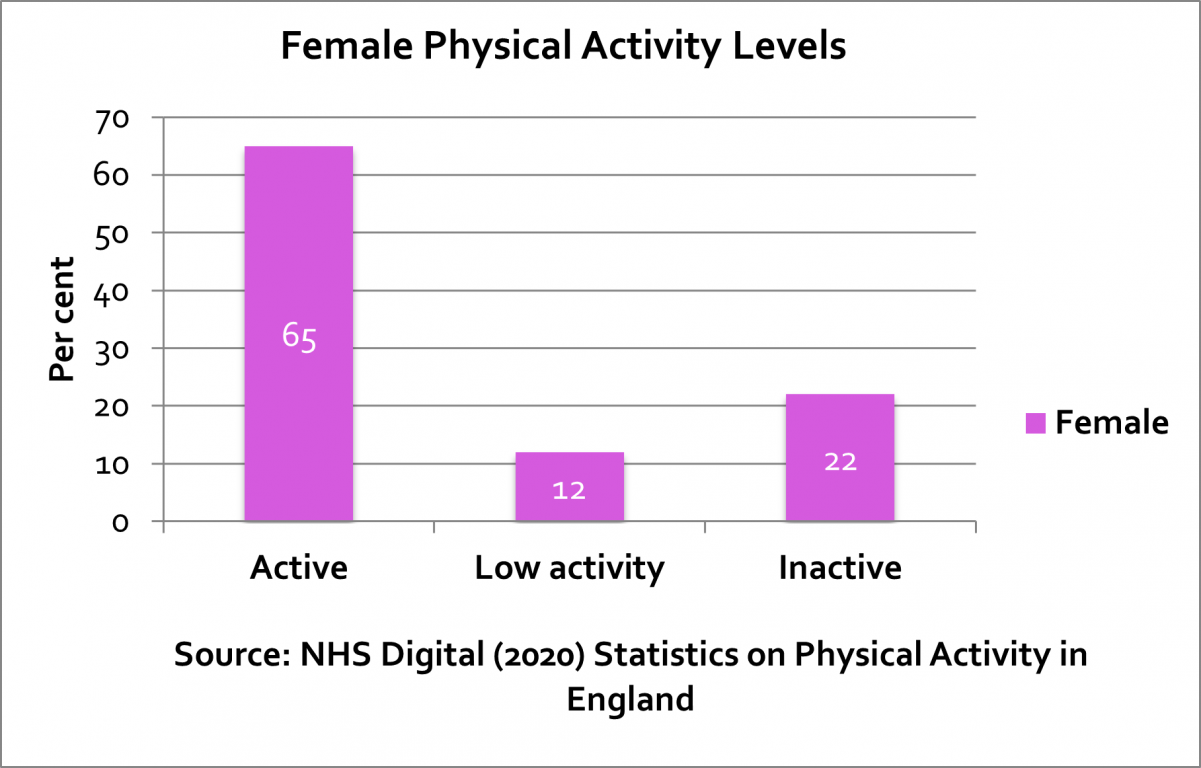
What you can do to stay in great shape?
- Get checked out. The most important thing if you’ve not been active for a while, is to make sure that you get checked out by a healthcare professional first – they can advise you on getting started and exercising safely. Start easy and listen to your body’s reactions.
- Break it up. If you’re new to exercise or out of the habit, it can seem daunting to aim for 150 minutes a week straightaway. Instead, think in 10 minute chunks and it will seem much more achievable. Before you know it, you’ll be in good enough shape to ramp it up.
- Make it fun. Making exercise part of your regular routine is much easier if you enjoy it, so keep trying new things until you find an exercise or a way of exercising that you really like.
- Look for new ways to get a burst of activity into your day. Put some ‘oomph’ into your vacuuming or gardening, take the stairs instead of the lift, or walk to the shops, rather than jumping in the car.
- Get an exercise buddy. Exercising with a friend is a great way to stay motivated and catch up at the same time. How about a gentle run in the park, or a pilates or yoga class, if that’s more your thing.
8. Type 2 Diabetes
Type 2 diabetes is a condition in where the amount of glucose (a type of sugar) in your blood is too high – this occurs because the body does not produce enough insulin, or the body is unable to properly use the insulin that is being produced. Having type 2 diabetes puts you at much higher risk of developing CHD and can make the effects of other risk factors, like high cholesterol and high blood pressure worse, too. (Ref 27, 28)
Women and diabetes
Around 90 per cent of those diagnosed are living with type 2 diabetes and 10 per cent have either Type 1 or rarer types. According to the HSE, the percentage of women with doctor-diagnosed diabetes has increased over the past 26 years, year-on-year, from 2% to 6% – the largest increase in numbers seen in women aged 45 years and over. And let’s not forget that there are many women out there with undiagnosed diabetes – around 4% of women in England, in 2019. (Ref 2)
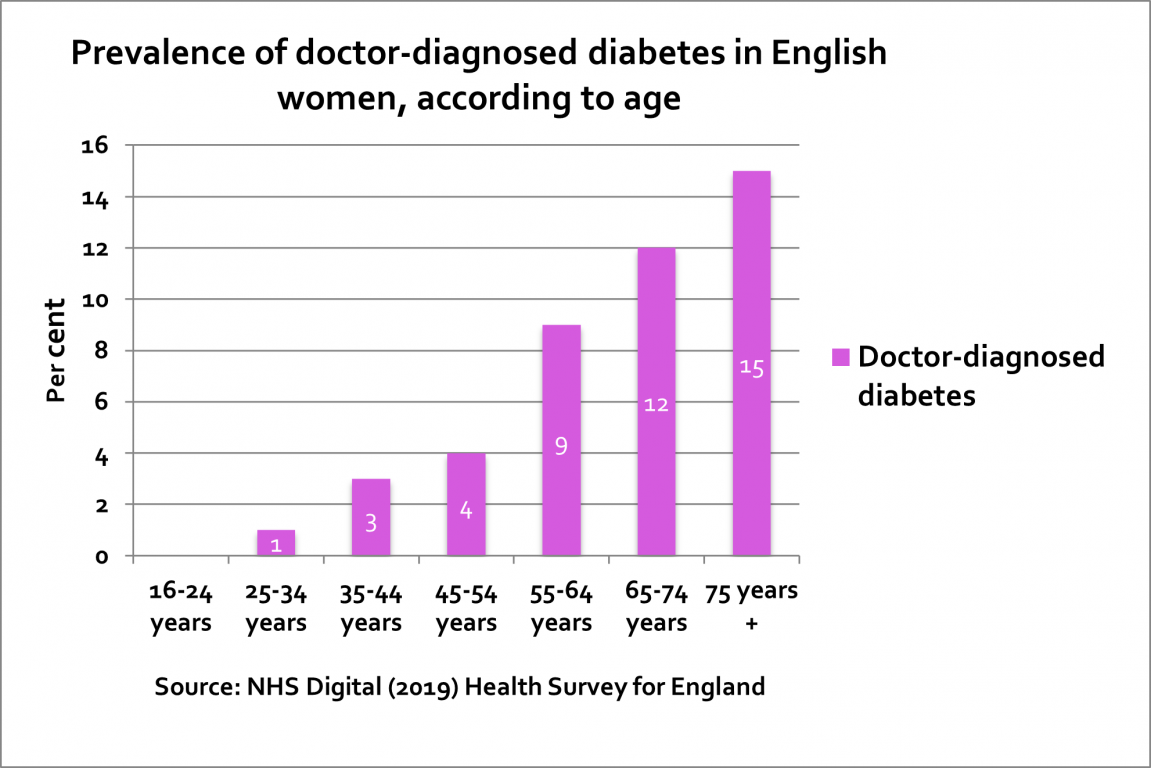
What can I do about my diabetes?
Type 2 diabetes is linked to being overweight or having a very high waist measurement, so achieving or maintaining a healthy weight can greatly reduce your risk of developing the condition. If you have type 2 diabetes, make sure that you are getting all the help you need to manage your condition, and take steps to combat other risks for CHD.
9. Stress
Although not a direct risk factor for CHD, stress, in particular workplace stress or job strain can lead to risky coping mechanisms, like smoking, overeating on high fat, sugary foods, drinking too much alcohol and being less physically active – none of which is good for your heart. (Ref 29)
Women and stress
According to the National Study of Health and Wellbeing, one in five women in England suffers with mental health such as depression and generalised anxiety (Ref 30), which can trigger unhealthy eating and lifestyle behaviours, and in turn, negatively impact heart health.
What you can do to stay calm?
- If job stress is getting the better of you, ask your boss if there are any relevant courses you could go on. Time management or dealing with difficult people for example, to lessen the work.
- Make time and take time to relax. It’s not just the kids or grand kids that need ‘time out’ – you do, too. Make relaxation time a priority for yourself, whether it is taking up a new hobby, going for a walk, listening to music or just enjoying a good book.
- Use strategies such as mindfulness, where you try to live in the moment without worrying about the past or future, or cognitive behavioural therapy (CBT), where you problem solve by changing your thought patterns.
- Or, how about joining a yoga class? Research has found that the practice of yoga can not only enhance muscular strength and body flexibility, but it can reduce stress and anxiety, improve sleep patterns, and even promote and improve circulation. (Ref 31)
10. Sleep
Getting enough good quality sleep is so important for good physical and mental health. A lack of sleep and interrupted sleep has also been linked to an increased risk of CHD, weight gain, type 2 diabetes and high blood pressure. (Ref 32, 33)
As a basic rule of thumb, most adult women need between seven and nine hours of sleep every night, but the ideal amount of sleep for you, depends on many things, including your day-to-day activities, physical exercise and overall health.
Women and sleep
Sleep surveys tells us that women living in the UK on average, sleep for 6.36 hours each night, so most women are missing out on some important shut-eye. (Ref 34)
What you can do sleep well?
- Create a healthy bedtime routine – avoid too much caffeine, limit alcohol and don’t stay up late staring at TV and phone screens for too Also removing devices from the bedroom and ensuring it’s not too hot can all help you drift off into a peaceful slumber.
- Make a sleep diary so you can track your sleep habits over a few weeks, and learn more about your sleep patterns and needs.
Take home message for women….
It can sometimes feel overwhelming when you look at all the things you might need to change in your life to improve your cholesterol levels and heart health, but the reality is it doesn’t need to be that complex. Following a healthy, balanced diet with plenty of plant based foods and slowly incorporating new healthy routines into your life, like swapping in Benecol® foods, is the best way to achieve and maintain healthy cholesterol levels and reduce your risk of developing CHD.
For more information on women and heart disease; reducing your risk, download the British Heart Foundation guide
* Plant stanol ester has been shown to lower cholesterol. High cholesterol is a risk factor in the development of coronary heart disease.
